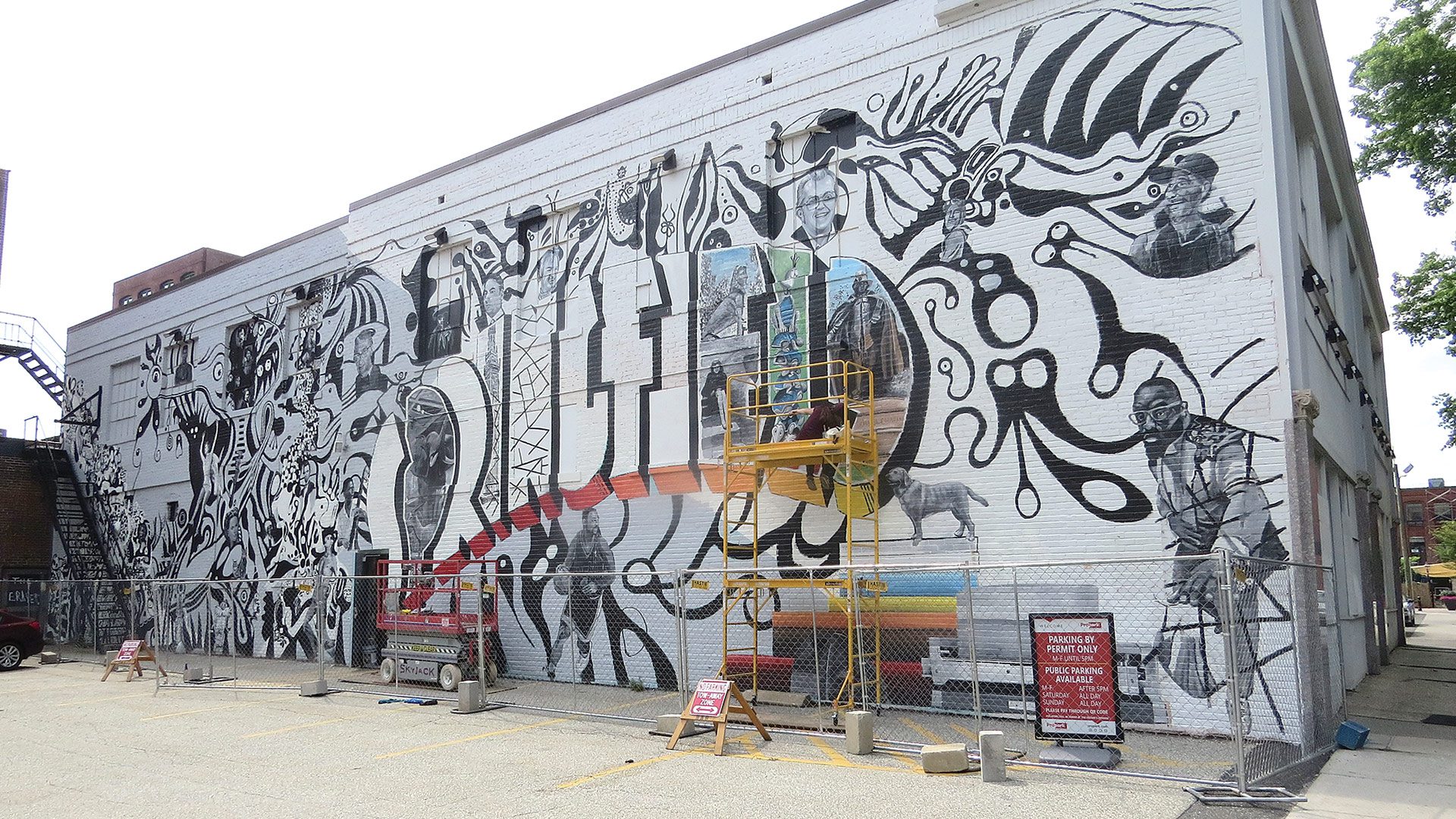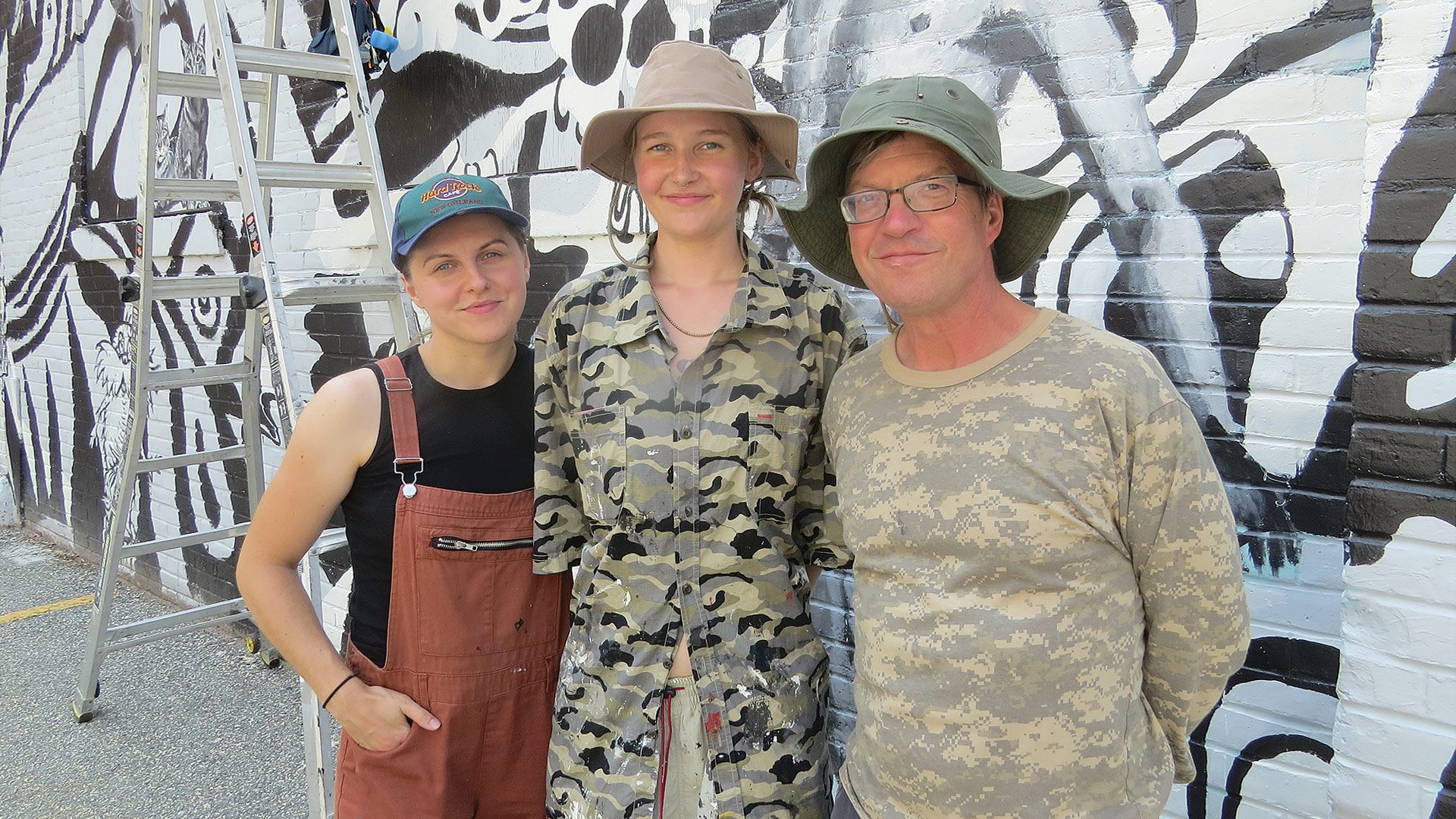
New Mural Captures Springfield’s History, Firsts, Character
Creating a ‘Time Machine’

The mural on Bridge Street remains a work in progress.
You’ll need more than a glance to take in, and fully appreciate, the mural being created on the south-facing wall of the old Skyplex Building on Bridge Street in Springfield.
You’ll probably need at least 10 minutes to fully absorb all the images on the 100-foot-long wall. There are dozens of them, large and small.
But you’ll also need a cheat sheet of sorts (a few different ones will be created — more on that later) and probably easy access to Wikipedia.
That’s because, while some of the people can be easily identified (Muhammad Ali, Abraham Lincoln, and even Peter L. Picknelly, among them), most of them are far more obscure and need some explaining, at least when it comes to their connection to, and importance to, the City of Homes.
And that’s part of the charm, if that’s the right word, of this project, which is one of the more ambitious projects to date of City Mosaic, a nonprofit organization that has brought many colorful and, in some cases, informative murals to downtown Springfield — and, in the process, reactivated a number of properties and made them conversation pieces.
Such was the case with another huge work of art just around the corner on Worthington Street. That project involved the recreation of wall advertising that was on the building more than a half-century ago, as well as a few images of personalities from the past and present.
John Simpson, the lead artist on that project, said some have referred to it as a “time machine,” and asked that he create another one at the Skyplex building, another somewhat underutilized property that is slated to become home to another brewery.

And he a team of artists, including Madden Sterrett and Susan Riano, have done just that.
“We wanted to blend many of the city’s historic firsts with historical figures, and modern community members, such as Mayor [Domenic] Sarno,” Simpson said. “We want to have the past connect with the present — and have it connect with the future.”
While the wall, which is a work in progress that should be completed “soon,” according to Simpson, features some well-known personalities and landmarks (such as the Puritan statue in front of the library) that need no explanation as to why they are pictured, many of them do.
Let’s start with Abraham Lincoln. According to local legend, the name ‘Republican Party,’ the party of Lincoln, originated in Springfield. Meanwhile, his wife, Mary Todd Lincoln, is said to have taken in shows at the Paramount Theater. As for Ali, he had connections to a mosque in the city, and is said to have visited it while training in Chicopee for his first fight against Sonny Liston.
Frederick Douglass also has a presence on the wall. Simpson said he visited Springfield several times, at least once to meet with fellow abolitionist John Brown about his raid on Harper’s Ferry, which started the Civil War.
There’s also the artist James Whistler, famous for the composition known as Whistler’s Mother. While born in Lowell, he did live in Springfield for a time, Simpson said. There are a few images of Eleanor Powell, a dancer and actress (she was in a few movies with Fred Astaire) who was also born in Springfield.
As was the actor Kurt Russell. There’s a small image of him portraying the character he is perhaps best known for, Snake Plissken, from both Escape from New York and Escape from L.A.
Former NBA star Travis Best, another Springfield native, is on the wall, as is Gwen Ifill, the journalist, television newscaster, and author, who was born in New York but later relocated with her family to Springfield and graduated from Classical High School.
There’s also June Foray (born June Lucille Forer), who grew up in Springfield and later became the voice of Rocky the Flying Squirrel and a host of other characters.
There aren’t many — if any — people who would recognize Foray from the image on the wall. And that’s why there will be a plaque, or key, to the images, explaining what they are, Simpson explained, adding that there are plans to print flyers to hand out at the restaurants — Granny’s Baking Table and the Osteria — that have windows facing the mural.
“Already, people are asking the waiters and the owners of these establishments who the people are on this wall,” he said, adding that this is one of the main objectives of this project — to get people talking and asking questions — about the wall, and about the city depicted on it.
Evan Plotkin, president of NAI Plotkin, collaborator with Simpson on several art-related projects in and around downtown, and leader of efforts to reactivate properties in that area, agreed.
“They’ve captured a moment in time, and the history and character of the city,” he said of the artists. “And while doing so, they’ve brought this property back to prominence; people are talking about it, and in the present and future tenses. That’s what these murals do.”
There is still some work to do on the mural, especially in and around the letters that spell out SPRINGFIELD, Simpson said, noting that many more characters, firsts, and landmarks will be added before the wall is officially finished. He mentioned an image of the Basketball Hall of Fame and perhaps something depicting the M-1 rifle, produced at the Springfield Armory, and its inventor, John Garand, as likely additions.
But already, those behind the project are accomplishing their primary mission. They’re creating that time machine, and they’re prompting people to stop, look, point, maybe ask some questions, get some answers, learn about Springfield, and celebrate the city and its history.
That’s a lot to ask from a mural, but this one does all that and more.
—George O’Brien




